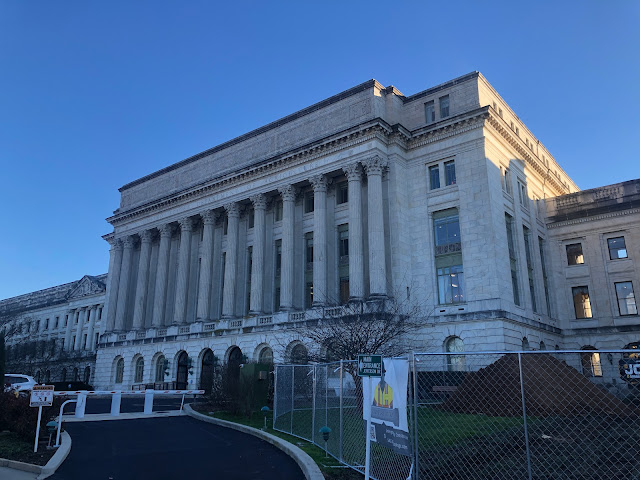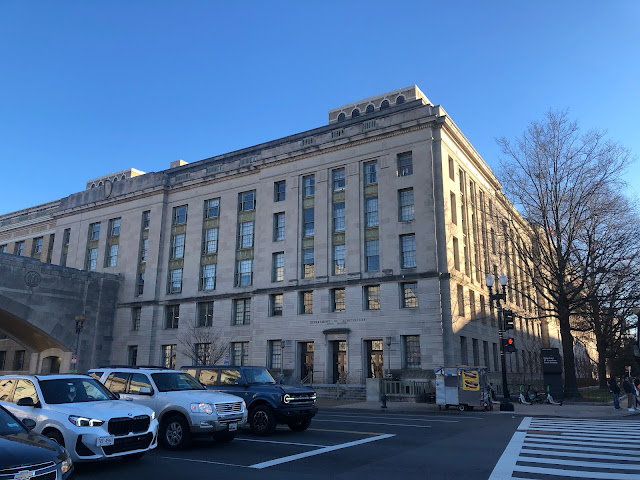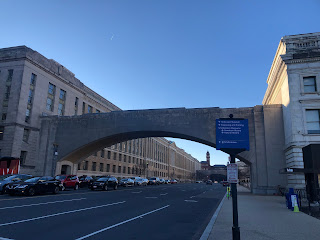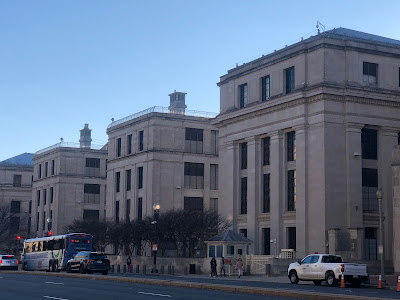*Originally published on another blog of mine, Miscellaneous Notes, now republished here with slight edits and modifications*
FEATURING — Department of Agriculture; Bureau of Engraving and Printing
Today is the first business day of 2024, so I set out to visit two more post offices and two more postal (or at least postally relevant) facilities. All four are situated on the southwestern corner of the National Mall, so a comfortable 30 minute or so by foot from where I live and not too hard to take in in one go.
The Department of Agriculture
The Department of Agriculture (USDA) Headquarters houses another of USPS’ branches, located in its newer South Building, constructed in the 1930s to accommodate the growing Department, which before then had to be cramped into the Beaux-Arts Jamie L. Whitten Building (built in 1908) across the street. To ensure easy movement between those two structures two footbridges were added in 1936 that straddle Independence Ave with elegantly simplistic single arches.



Led blindly by my digital map I ended up outside its southern facade , in front of an archway leading to the central court. I had no idea whether I should turn around and look for a more regular entrance, and the archway itself is blocked by a traffic gate and doesn’t look too welcoming. So I asked the security guard for guidance, who told me the USDA post office is not open to the public, and access is limited to those bearing “badges” or more generally federal employees. I later learned that the State Department station, the single other USPS branch in a federal executive office building, is also off-limits.
As much of a bummer as it is, I would still like to note the strong historical connections between the Department of Agriculture and its postal counterpart. By the 1820s subsistence agriculture (where a farming household produces enough for their own consumption and has little surplus to sell) had begun to give way to commercial farming, as rapid urbanization demanded more food and better transportation created a potentially profitable market for their products. This prompted the Patent Office (whose Agricultural Division was the precursor to today’s USDA) to systematically collect and distribute the best possible plant variants, usually in the form of seeds in sealed packages, which obviously were to be delivered by the postal service. By 1860, roughly 2.4 million of these packages passed through its system each year.
Then in 1862 the USDA was created as a cabinet-level office to better coordinate and improve farming practices, and inherited from its progenitor the important duty of seed distribution and expanded it to an unprecedented scale — In 1895 alone 9.9 million packs of seeds were sent out, and before 1902 the Department essentially acted as America’s most prominent commercial seed company, with the postal service running its errands.
But the postal system does not discriminate amongst its users, and in the 1880s other competitors began to emerge. The most successful of them was probably the W. Atlee Burpee Company, first founded in 1876 as a local breeder and seller of farm animals but soon moving on to sell seeds via mail order. Burpee’s business enjoyed greater success into the 1890s, probably a combined result of him introducing the ubiquitous “Iceberg” lettuce and an 1896 postal office reform that established the then-controversial Rural Free Delivery (RFD), which opened up the massive rural market to mail-order companies like the famous Montgomery & Ward and Burpee.
Today the USDA has largely faded out of the world of seed delivery, but it still warns farmers about invasive species spreading through mail while the USPS maintains the stringent legal requirements for the sending of plants and animals via its system. This brief historical excursion will not compensate for my failure to physically tour the USDA, but it will have to do.
The Bureau of Engraving and Printing

The BEP headquarters is a mere 3 minute walk from the USDA, and features guided tours and a gift shop that unfortunately sells nothing postal — I did not go on a tour today, but should I do so in the future will most definitely write about it here. The bureau was responsible for printing most of these stamps issued between 1894 and 2005 — Myriad private companies competed for stamp-printing contracts prior to that, and since 2011 all stamps were printed in-house by the USPS.
